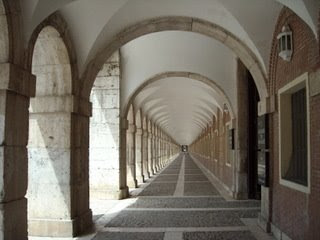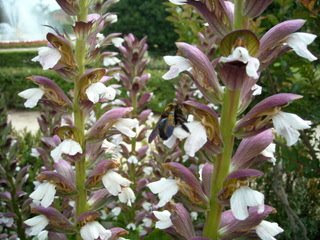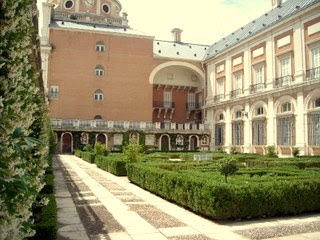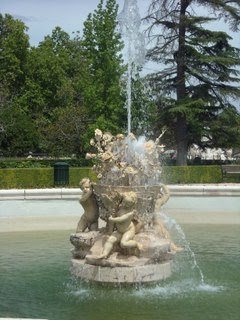We walked down from the Moorish style railway station - shades of Toledo - along tree-lined roads, stopping at a corner cafe bar for a break, and then rounded said corner to find we were almost there. The palace of Aranjuez used to be a royal summer residence, an escape from the heat of Madrid. The town is 47km south of Madrid, and 200m lower. It's got a proper river, the Rio Tajo (the River Tagus, en route from Toledo to the sea) - and another one too, as I recall - and it's own micro-climate, which enables local farmers to grow strawberries and asparagus. Which makes it downright lush compared with sun-baked Madrid. In the past, I get the impression that Aranjuez was to Madrid what Kent was to London. - its kitchen garden.
Anyway, what was a royal refuge is now a peaceful, elegant day out for us plebs, about 40 minutes by train (if that) from Madrid Atocha. In the summer months, you can ride on the Tren de Fresas, the 19thC steam train that used to transport strawberries to Madrid, along the line that was built for the purpose. The train staff wear 19thC dress, and serve strawberries to all the passengers. Or, if it's sold out, there's a regular service every 10 minutes or so, all day every day. It was. Ah well.
On the Sunday we went, the town was quiet and closed, apart from the cafe bars and restaurants. The area closest to the palace is quite old, as we discovered when we went looking for lunch, though it has it's share of tall apartment buildings.

We left it rather late for a proper tour of the palace itself, and I for one was more interested in the gardens than the furniture, so we saved the palace, and the porcelain house, the barge house and several other curiosities of royal leisure for another occasion.
NOTE TO SELF FOR NEXT MAY & JUNE. We just missed the Música Antigua Aranjuez, the annual Early Music Festival, this year. The concerts are held at the palace itself. Don't miss next year's festival! P.S. Especially if Jordi Savall & family are on. End of note to self.
Crossing the big cobbled square, and taking time to admire some handsome stone and brick buildings, we passed through a gateway into the first of the gardens.





 Here's an impressive water feature. I imagine they wanted to protect the palace from the river.
Here's an impressive water feature. I imagine they wanted to protect the palace from the river.
(Madrid's Rio Manzanares was a proper river in Roman times, and maybe still qualified in the 16thC, when Madrid replaced Toledo as the capital but it hardly counts these days. You can see the attraction of all this rippling cool in the summer's heat.)

This is a relic (evidently still in use) of a water mangement system that goes back to the Moors and beyond. Water is directed through acequias (irrigation channels) which can be opened up and shut off at various points, to allow proper irrigation of all parts of a piece of land. Andalucian farmers used to agree responsibility for maintaining their sections of the acequia network, and a schedule for opening and closing the water flow to the different farms on the network.


The Rio Tajo continues beyond the palace walls, with alder, willow and honeysuckle growing wild along its banks.
Maybe the odd beetle?
If you're into that kind of thing?

















No comments:
Post a Comment